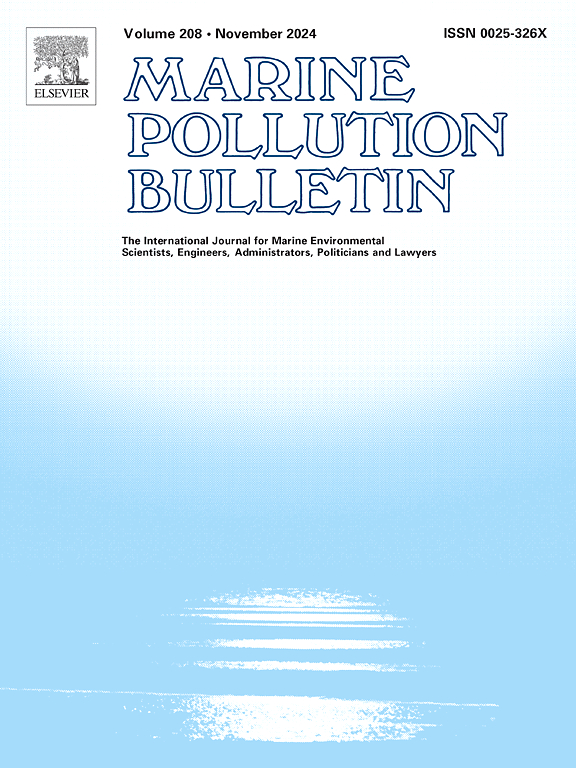印度西南海岸Vembanad湿地生态系统表层沉积物中的多环芳烃(PAHs):传播、来源分配、生态和公共卫生影响的综合评估
IF 4.9
3区 环境科学与生态学
Q1 ENVIRONMENTAL SCIENCES
引用次数: 0
摘要
本研究评估了16种多环芳烃(PAHs)在Vembanad湖表层沉积物中的分布、来源、生态和人类健康风险。在季风期间,多环芳烃总量在47.1至424.4纳克/克之间变化,在非季风期间为155.9至749.4纳克/克,这仍然低于全球大多数其他沉积物研究中发现的水平。多环芳烃与TOC呈显著正相关(r = 0.457, p <;0.05),淤泥(r = 0.521, p <;0.01),粘土(r = 0.533, p <;0.05),表明多环芳烃被细粒颗粒强烈吸收。Vembanad湖中多环芳烃的来源主要归因于各种人为活动,包括工业排放、生活污水、港口作业、车辆排放、石油泄漏以及周围城市和农业地区的径流。多因素统计分析表明,燃烧源(煤或生物质燃烧占50.69%)、汽车尾气排放占48.08%、产岩源占1.23%是多环芳烃的主要来源。根据沉积物质量评价,苊(Acy)在季风季节表现出偶发的生物效应,而芘(Py)在非季风季节表现出偶发的生物效应。多环芳烃的非致癌风险非常低(HI <1)。虽然致癌风险中等,但发现BaP具有显著的致癌风险(ILCR >10−3)。因此,研究区域需要持续监测和污染控制措施。本研究首次对Vembanad湿地的多环芳烃进行了全面的健康风险评估,为潜在的人类暴露和相关风险提供了有价值的见解,并填补了区域环境研究的关键空白。本文章由计算机程序翻译,如有差异,请以英文原文为准。

Polycyclic aromatic hydrocarbons (PAHs) in surficial sediments of Vembanad wetland ecosystem, southwest coast of India: An integrated assessment of dissemination, source apportionment, ecological and public health implication
The present study assessed the dissemination, sources, ecological and human health risks of 16 polycyclic aromatic hydrocarbons (PAHs) in surface sediments collected from Vembanad Lake. Total PAHs varied from 47.1 to 424.4 ng/g during monsoon and 155.9 to 749.4 ng/g during nonmonsoon, which remain below the levels found in most other sediment studies conducted globally. Strong positive correlations were found between PAHs and TOC (r = 0.457, p < 0.05), silt (r = 0.521, p < 0.01), and clay (r = 0.533, p < 0.05), suggesting that PAHs are strongly absorbed onto fine-grained particles. The origin of PAHs in Vembanad Lake is predominantly attributed to diverse anthropogenic activities, including industrial discharges, domestic sewage, port operations, vehicular emissions, oil spills, and runoff from surrounding urban and agricultural areas. Multivariate statistical analysis showed that combustion sources (coal or biomass combustion: 50.69 %), vehicular emissions (48.08 %) and petrogenic sources (1.23 %) are the main sources of PAHs. According to sediment quality assessment, acenaphthylene (Acy) in monsoon seasons exhibited occasional biological effects, while pyrene (Py) did so in the nonmonsoon seasons. Noncarcinogenic risks due to PAHs were very low (HI <1). While carcinogenic risks were moderate, BaP was found to pose significant carcinogenic risks (ILCR >10−3). Thus, the study area requires continuous monitoring and pollution control measurements. This study presents the first comprehensive health risk assessment of PAHs in the Vembanad wetland, offering valuable insights into potential human exposure and associated risks, and addressing a critical gap in regional environmental research.
求助全文
通过发布文献求助,成功后即可免费获取论文全文。
去求助
来源期刊

Marine pollution bulletin
环境科学-海洋与淡水生物学
CiteScore
10.20
自引率
15.50%
发文量
1077
审稿时长
68 days
期刊介绍:
Marine Pollution Bulletin is concerned with the rational use of maritime and marine resources in estuaries, the seas and oceans, as well as with documenting marine pollution and introducing new forms of measurement and analysis. A wide range of topics are discussed as news, comment, reviews and research reports, not only on effluent disposal and pollution control, but also on the management, economic aspects and protection of the marine environment in general.
 求助内容:
求助内容: 应助结果提醒方式:
应助结果提醒方式:


